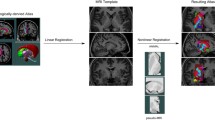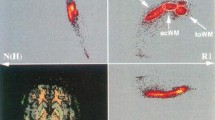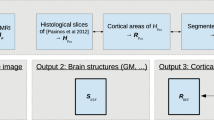Abstract
Stereotaxy is based on the precise image-guided spatial localization of targets within the human brain. Even with the recent advances in MRI technology, histological examination renders different (and complementary) information of the nervous tissue. Although several maps have been selected as a basis for correlating imaging results with the anatomical locations of sub-cortical structures, technical limitations interfere in a point-to-point correlation between imaging and anatomy due to the lack of precise correction for post-mortem tissue deformations caused by tissue fixation and processing. We present an alternative method to parcellate human brain cytoarchitectural regions, minimizing deformations caused by post-mortem and tissue-processing artifacts and enhancing segmentation by means of modified high thickness histological techniques and registration with MRI of the same specimen and into MNI space (ICBM152). A three-dimensional (3D) histological atlas of the human thalamus, basal ganglia, and basal forebrain cholinergic system is displayed. Structure’s segmentations were performed in high-resolution dark-field and light-field microscopy. Bidimensional non-linear registration of the histological slices was followed by 3D registration with in situ MRI of the same subject. Manual and automated registration procedures were adopted and compared. To evaluate the quality of the registration procedures, Dice similarity coefficient and normalized weighted spectral distance were calculated and the results indicate good overlap between registered volumes and a small shape difference between them in both manual and automated registration methods. High thickness high-resolution histological slices in combination with registration to in situ MRI of the same subject provide an effective alternative method to study nuclear boundaries in the human brain, enhancing segmentation and demanding less resources and time for tissue processing than traditional methods.









Similar content being viewed by others
References
Afshar F, Watkins ES, Yap JC (1978) Stereotaxic atlas of the human brainstem and cerebellar nuclei: a variability study. Raven Press, New York
Alegro M, Loring B, Alho E et al (2016) Multimodal whole brain registration: MRI and high resolution histology. http://www.cv-foundation.org/openaccess/content_cvpr_2016_workshops/w15/papers/Alegro_Multimodal_Whole_Brain_CVPR_2016_paper.pdf. Accessed 9 Sep 2016
Alho ATDL, Hamani C, Alho EJL et al (2017) Magnetic resonance diffusion tensor imaging for the pedunculopontine nucleus: proof of concept and histological correlation. Brain Struct Funct. https://doi.org/10.1007/s00429-016-1356-0
Alic L, Haeck JH (2010) Multi-modal image registration: matching MRI with histology. SPIE Medical Imaging, San Diego
Amunts K, Lepage C, Borgeat L et al (2013) BigBrain: an ultrahigh-resolution 3D human brain model. Science 340:1472–1475. https://doi.org/10.1126/science.1235381
Andrew J, Watkins ES (1969) A stereotaxic atlas of the human thalamus and adjacent structures: a variability study. Williams and Wilkins, Baltimore
Aoki S, Okada Y, Nishimura K et al (1989) Normal deposition of brain iron in childhood and adolescence: MR imaging at 1.5 T. Radiology 172:381–385. https://doi.org/10.1148/radiology.172.2.2748819
Avants BB, Epstein CL, Grossman M, Gee JC (2008) Symmetric diffeomorphic image registration with cross-correlation: evaluating automated labeling of elderly and neurodegenerative brain. Med Image Anal 12:26–41. https://doi.org/10.1016/j.media.2007.06.004
Bauchot R (1967) Modifications of brain weight in the course of fixation. J Für Hirnforsch 9:253–283
Butler T, Zaborszky L, Pirraglia E et al (2014) Comparison of human septal nuclei MRI measurements using automated segmentation and a new manual protocol based on histology. NeuroImage 97:245–251. https://doi.org/10.1016/j.neuroimage.2014.04.026
Carballo-Barreda M, RodríGuez-Rojas R, Torres-Montoya A, LóPez-Flores G (2007) Computerized atlas for image-guided stereotactic functional neurosurgery. Neurocir Astur Spain 18:478–484
Casanova MF, Kreczmanski P, Trippe J 2nd et al (2008) Neuronal distribution in the neocortex of schizophrenic patients. Psychiatry Res 158:267–277. https://doi.org/10.1016/j.psychres.2006.12.009
Chakravarty MM, Bertrand G, Hodge CP et al (2006) The creation of a brain atlas for image guided neurosurgery using serial histological data. NeuroImage 30:359–376. https://doi.org/10.1016/j.neuroimage.2005.09.041
Crum WR, Camara O, Hill DLG (2006) Generalized overlap measures for evaluation and validation in medical image analysis. IEEE Trans Med Imaging 25:1451–1461. https://doi.org/10.1109/TMI.2006.880587
Dandy WE (1918) Ventriculography following the injection of air into the cerebral ventricles. Ann Surg 68:5–11
Dice LR (1945) Measures of the amount of ecologic association between species. Ecology 26:297–302. https://doi.org/10.2307/1932409
Drayer B, Burger P, Darwin R et al (1986) MRI of brain iron. AJR Am J Roentgenol 147:103–110. https://doi.org/10.2214/ajr.147.1.103
Duyn JH (2012) The future of ultra-high field MRI and fMRI for study of the human brain. Neuroimage 62:1241–1248. https://doi.org/10.1016/j.neuroimage.2011.10.065
Emmers R, Tasker R (1975) The human somesthetic thalamus: with maps for physiological target localization during stereotactic neurosurgery. Raven Press, New York
Ewers M, Frisoni GB, Teipel SJ et al (2011) Staging Alzheimer’s disease progression with multimodality neuroimaging. Prog Neurobiol 95:535–546. https://doi.org/10.1016/j.pneurobio.2011.06.004
Ewert S, Plettig P, Li N et al (2017) Toward defining deep brain stimulation targets in MNI space: a subcortical atlas based on multimodal MRI, histology and structural connectivity. NeuroImage. https://doi.org/10.1016/j.neuroimage.2017.05.015
Fonoff ET, Campos WK, Mandel M et al (2012) Bilateral subthalamic nucleus stimulation for generalized dystonia after bilateral pallidotomy. Mov Disord Off J Mov Disord Soc 27:1559–1563. https://doi.org/10.1002/mds.25127
Fonov V, Evans AC, Botteron K et al (2011) Unbiased average age-appropriate atlases for pediatric studies. NeuroImage 54:313–327. https://doi.org/10.1016/j.neuroimage.2010.07.033
François C, Yelnik J, Percheron G (1996) A stereotaxic atlas of the basal ganglia in macaques. Brain Res Bull 41:151–158
Franklin K, Paxinos G (2008) The mouse brain in stereotaxic coordinates. Academic Press, New York
Ganser KA, Dickhaus H, Metzner R, Wirtz CR (2004) A deformable digital brain atlas system according to Talairach and Tournoux. Med Image Anal 8:3–22
Grinberg L, Heinsen H (2007) Computer-assisted 3D reconstruction of the human basal forebrain complex. Dement Neuropsychol 1:140–146
Grinberg LT, Amaro E Jr, Teipel S et al (2008) Assessment of factors that confound MRI and neuropathological correlation of human postmortem brain tissue. Cell Tissue Bank 9:195–203. https://doi.org/10.1007/s10561-008-9080-5
Grinberg LT, Amaro Junior E, da Silva AV et al (2009) Improved detection of incipient vascular changes by a biotechnological platform combining post mortem MRI in situ with neuropathology. J Neurol Sci 283:2–8. https://doi.org/10.1016/j.jns.2009.02.327
Haakma W, Pedersen M, Froeling M et al (2016) Diffusion tensor imaging of peripheral nerves in non-fixed post-mortem subjects. Forensic Sci Int 263:139–146. https://doi.org/10.1016/j.forsciint.2016.04.001
Hallgren B, Sourander P (1958) The effect of age on the non-haemin iron in the human brain. J Neurochem 3:41–51
Hassler R, Schaltenbrand G, Walker E (1982) Architectonic organization of the thalamic nuclei. In: Schaltenbrand G, Walker E (eds) Stereotaxy of the human brain: anatomical, physiological and clinical applications, 2nd edn. George Thieme Verlag, Stuttgart
Heckers S, Heinsen H, Heinsen Y, Beckmann H (1991) Cortex, white matter, and basal ganglia in schizophrenia: a volumetric postmortem study. Biol Psychiatry 29:556–566
Heinsen H, Heinsen YL (1991) Serial thick, frozen, gallocyanin stained sections of human central nervous system. J Histotechnol 14:167–173
Heinsen H, Henn R, Eisenmenger W et al (1994a) Quantitative investigations on the human entorhinal area: left–right asymmetry and age-related changes. Anat Embryol (Berl) 190:181–194
Heinsen H, Strik M, Bauer M et al (1994b) Cortical and striatal neurone number in Huntington’s disease. Acta Neuropathol (Berl) 88:320–333
Heinsen H, Rüb U, Gangnus D et al (1996) Nerve cell loss in the thalamic centromedian–parafascicular complex in patients with Huntington’s disease. Acta Neuropathol (Berl) 91:161–168
Heinsen H, Arzberger T, Schmitz C (2000) Celloidin mounting (embedding without infiltration)—a new, simple and reliable method for producing serial sections of high thickness through complete human brains and its application to stereological and immunohistochemical investigations. J Chem Neuroanat 20:49–59
Hirai T, Jones EG (1989) A new parcellation of the human thalamus on the basis of histochemical staining. Brain Res Brain Res Rev 14:1–34
Horn A, Kühn AA (2015) Lead-DBS: a toolbox for deep brain stimulation electrode localizations and visualizations. NeuroImage 107:127–135. https://doi.org/10.1016/j.neuroimage.2014.12.002
Ilinsky IA, Kultas-Ilinsky K, Knosp B (2002) Stereotactic atlas of the Macaca mulatta thalamus and adjacent basal ganglia nuclei. Springer, Boston
Jenkinson M, Beckmann CF, Behrens TEJ et al (2012) FSL. NeuroImage 62:782–790. https://doi.org/10.1016/j.neuroimage.2011.09.015
Kilimann I, Grothe M, Heinsen H et al (2014) Subregional basal forebrain atrophy in Alzheimer’s disease: a multicenter study. J Alzheimers Dis JAD 40:687–700. https://doi.org/10.3233/JAD-132345
König JFR, Klippel RA (1963) The rat brain: a stereotaxic atlas of the forebrain and lower parts of the brain stem. Williams and Wilkins, Baltimore
Konukoglu E, Glocker B, Ye DH et al (2012) Discriminative segmentation-based evaluation through shape dissimilarity. IEEE Trans Med Imaging 31:2278–2289
Konukoglu E, Glocker B, Criminisi A, Pohl KM (2013) WESD—weighted spectral distance for measuring shape dissimilarity. IEEE Trans Pattern Anal Mach Intell 35:2284–2297
Krauth A, Blanc R, Poveda A et al (2010) A mean three-dimensional atlas of the human thalamus: generation from multiple histological data. NeuroImage 49:2053–2062. https://doi.org/10.1016/j.neuroimage.2009.10.042
Kretschmann HJ, Tafesse U, Herrmann A (1982) Different volume changes of cerebral cortex and white matter during histological preparation. Microsc Acta 86:13–24
Kroon JP, Riley AL (1986) A microcomputer-based system for stereotaxic coordinates in the rat brain. Physiol Behav 38:593–596
Kumazawa-Manita N, Katayama M, Hashikawa T, Iriki A (2013) Three-dimensional reconstruction of brain structures of the rodent Octodon degus: a brain atlas constructed by combining histological and magnetic resonance images. Exp Brain Res 231:65–74. https://doi.org/10.1007/s00221-013-3667-1
Lanciego JL, Vázquez A (2012) The basal ganglia and thalamus of the long-tailed macaque in stereotaxic coordinates. A template atlas based on coronal, sagittal and horizontal brain sections. Brain Struct Funct 217:613–666. https://doi.org/10.1007/s00429-011-0370-5
Mai JK, Paxinos G, Voss T (2008) Atlas of the human brain. Academic Press, New York
Martin RF, Bowden DM (1996) A stereotaxic template atlas of the macaque brain for digital imaging and quantitative neuroanatomy. NeuroImage 4:119–150. https://doi.org/10.1006/nimg.1996.0036
Martinez RCR, Hamani C, de Carvalho MC et al (2013) Intraoperative dopamine release during globus pallidus internus stimulation in Parkinson’s disease. Mov Disord Off J Mov Disord Soc. https://doi.org/10.1002/mds.25691
Mesulam MM, Mufson EJ, Wainer BH, Levey AI (1983) Central cholinergic pathways in the rat: an overview based on an alternative nomenclature (Ch1–Ch6). Neuroscience 10:1185–1201
Morel A (2007) Stereotactic atlas of the human thalamus and basal ganglia. Informa Healthcare, New York
Morel A, Magnin M, Jeanmonod D (1997) Multiarchitectonic and stereotactic atlas of the human thalamus. J Comp Neurol 387:588–630
Niemann K, van Nieuwenhofen I (1999) One Atlas–Three Anatomies: relationships of the Schaltenbrand and Wahren Microscopic Data. Acta Neurochir (Wien) 141:1025–1038
Niemann K, Naujokat C, Pohl G et al (1994) Verification of the Schaltenbrand and Wahren stereotactic atlas. Acta Neurochir (Wien) 129:72–81
Nowinski WL, Belov D (2003) The Cerefy Neuroradiology Atlas: a Talairach–Tournoux atlas-based tool for analysis of neuroimages available over the internet. NeuroImage 20:50–57
Nowinski WL, Fang A, Nguyen BT et al (1997) Multiple brain atlas database and atlas-based neuroimaging system. Comput Aided Surg Off J Int Soc Comput Aided Surg 2:42–66. https://doi.org/10.1002/(SICI)1097-0150(1997)2:1<42:AID-IGS7>3.0.CO;2-N
Nowinski WL, Belov D, Thirunavuukarasuu A, Benabid AL (2005) A probabilistic functional atlas of the VIM nucleus constructed from pre-, intra- and postoperative electrophysiological and neuroimaging data acquired during the surgical treatment of Parkinson’s disease patients. Stereotact Funct Neurosurg 83:190–196. https://doi.org/10.1159/000091082
Nowinski WL, Liu J, Thirunavuukarasuu A (2006) Quantification and visualization of the three-dimensional inconsistency of the subthalamic nucleus in the Schaltenbrand–Wahren brain atlas. Stereotact Funct Neurosurg 84:46–55. https://doi.org/10.1159/000093722
Ono M, Kubik S, Abernathey CD (1990) Atlas of the cerebral sulci. G. Thieme Verlag/Thieme Medical Publishers, Stuttgart/New York
Paxinos G, Watson C (1986) The rat brain in stereotaxic coordinates. Academic Press, New York
Quester R, Schröder R (1997) The shrinkage of the human brain stem during formalin fixation and embedding in paraffin. J Neurosci Methods 75:81–89
Reese R, Pinsker MO, Herzog J et al (2012) The atypical subthalamic nucleus—an anatomical variant relevant for stereotactic targeting. Mov Disord Off J Mov Disord Soc 27:544–548. https://doi.org/10.1002/mds.24902
Reuter M, Rosas HD, Fischl B (2010) Highly accurate inverse consistent registration: a robust approach. NeuroImage 53:1181–1196. https://doi.org/10.1016/j.neuroimage.2010.07.020
Saleem KS, Logothetis NK (2012) A combined MRI and histology atlas of the rhesus monkey brain in stereotaxic coordinates. Academic Press, New York
Schaltenbrand G, Bailey P (1959) Introduction to stereotaxis with an atlas of the human brain, vol I: Text, vol II: Plate 1–57, vol III: Plate 58–76. Georg Thieme, Grune & Stratton:Stuttgart, New York
Schaltenbrand G, Hassler R, Wahren W (1977) Atlas for stereotaxy of the human brain: with an accompanying guide. Thieme, Stuttgart
Schulz G, Crooijmans HJA, Germann M et al (2011) Three-dimensional strain fields in human brain resulting from formalin fixation. J Neurosci Methods 202:17–27. https://doi.org/10.1016/j.jneumeth.2011.08.031
Schwarz AJ, Danckaert A, Reese T et al (2006) A stereotaxic MRI template set for the rat brain with tissue class distribution maps and co-registered anatomical atlas: application to pharmacological MRI. NeuroImage 32:538–550. https://doi.org/10.1016/j.neuroimage.2006.04.214
Shanta TR, Manocha SL, Bourne GH (1968) A stereotaxic atlas of the java monkey brain (Macaca irus). Basel, Karger, doi:10.1159/000390681
Simmons DM, Swanson LW (2009) Comparing histological data from different brains: sources of error and strategies for minimizing them. Brain Res Rev 60:349–367. 10.1016/j.brainresrev.2009.02.002
Small CS, Peterson DI (1982) The reliability of dimensions of formalin-fixed brains. Neurology 32:413–415
Spiegel EA, Wycis HT, Freed H (1952) Stereoencephalotomy: thalamotomy and related procedures. J Am Med Assoc 148:446–451. https://doi.org/10.1001/jama.1952.02930060028009
St-Jean P, Sadikot AF, Collins L et al (1998) Automated atlas integration and interactive three-dimensional visualization tools for planning and guidance in functional neurosurgery. IEEE Trans Med Imaging 17:672–680. https://doi.org/10.1109/42.736017
Talairach J (1957) Atlas d’anatomie stéréotaxique; repérage radiologique indirect des noyaux gris centraux des régions mésencéphalo-sous-optique et hypothalamique de l’homme. Masson, Paris
Talairach J, Tournoux P (1988) Co-planar stereotaxic atlas of the human brain: 3-dimensional proportional system: an approach to medical cerebral imaging. Thieme, Stuttgart
Teipel SJ, Meindl T, Grinberg L et al (2008) Novel MRI techniques in the assessment of dementia. Eur J Nucl Med Mol Imaging 35(Suppl 1):S58–S69. https://doi.org/10.1007/s00259-007-0703-z
Teipel SJ, Meindl T, Grinberg L et al (2011) The cholinergic system in mild cognitive impairment and Alzheimer’s disease: an in vivo MRI and DTI study. Hum Brain Mapp 32:1349–1362. https://doi.org/10.1002/hbm.21111
Teipel SJ, Flatz W, Ackl N et al (2014) Brain atrophy in primary progressive aphasia involves the cholinergic basal forebrain and Ayala’s nucleus. Psychiatry Res 221:187–194. https://doi.org/10.1016/j.pscychresns.2013.10.003
Toga AW, Samaie M, Payne BA (1989) Digital rat brain: a computerized atlas. Brain Res Bull 22:323–333
Van Buren JM, Borke RC (1972) Variations and connections of the human thalamus. Springer, Berlin
Yelnik J, Bardinet E, Dormont D et al (2007) A three-dimensional, histological and deformable atlas of the human basal ganglia. I. Atlas construction based on immunohistochemical and MRI data. NeuroImage 34:618–638. https://doi.org/10.1016/j.neuroimage.2006.09.026
Yoshida M (1987) Creation of a three-dimensional atlas by interpolation from Schaltenbrand–Bailey’s atlas. Appl Neurophysiol 50:45–48
Zaborszky L, Hoemke L, Mohlberg H et al (2008) Stereotaxic probabilistic maps of the magnocellular cell groups in human basal forebrain. NeuroImage 42:1127–1141. https://doi.org/10.1016/j.neuroimage.2008.05.055
Acknowledgements
The authors would like to thank the team participating on the São Paulo-Würzburg collaborative project. This includes all members of the Brain Bank of the Brazilian Aging Brain Research Group (BBBABSG) of the University of São Paulo Medical School, Mrs. E. Broschk and Mrs. A. Bahrke from the Morphological Brain Research Unit of the University of Würzburg, Germany.
Author information
Authors and Affiliations
Corresponding author
Ethics declarations
Funding source
This study was supported by resources from the University of Sao Paulo School of Medicine, Brazil and University of Würzburg, Germany. The author Eduardo Joaquim Lopes Alho was supported by a scholarship from CAPES (Coordenação de Aperfeiçoamento de Pessoal de Nível Superior) agency, Brazil, for doctoral studies at the University of Würzburg, Germany. The authors do not have personal financial or institutional interest in any of the drugs, materials, or devices described in this article.
Conflict of interest
The authors disclose any actual or potential conflict of interest including any financial, personal, or other relationships with other people or organizations within 3 years of beginning the submitted work that could inappropriately influence, or be perceived to influence, their work.
Ethical standards
The work described has been carried out in accordance with The Code of Ethics of the World Medical Association (Declaration of Helsinki).
Electronic supplementary material
Below is the link to the electronic supplementary material.
Supplementary material 1 (WMV 26324 kb)
Supplementary material 2 (WMV 21876 kb)
Supplementary material 3 (WMV 188761 kb)
Rights and permissions
About this article
Cite this article
Alho, E.J.L., Alho, A.T.D.L., Grinberg, L. et al. High thickness histological sections as alternative to study the three-dimensional microscopic human sub-cortical neuroanatomy. Brain Struct Funct 223, 1121–1132 (2018). https://doi.org/10.1007/s00429-017-1548-2
Received:
Accepted:
Published:
Issue Date:
DOI: https://doi.org/10.1007/s00429-017-1548-2





